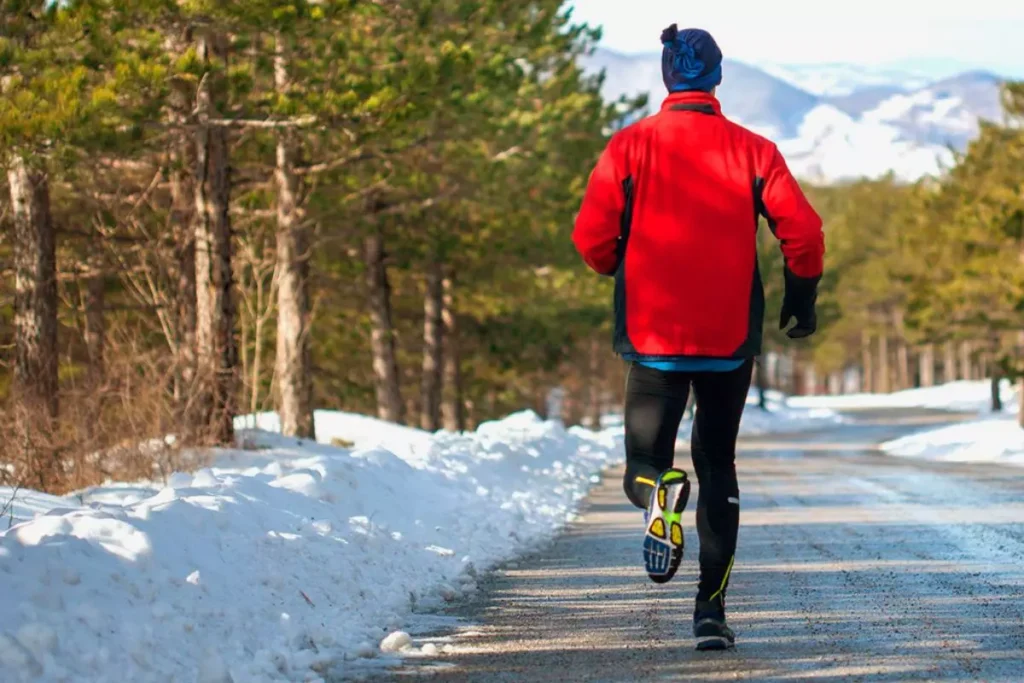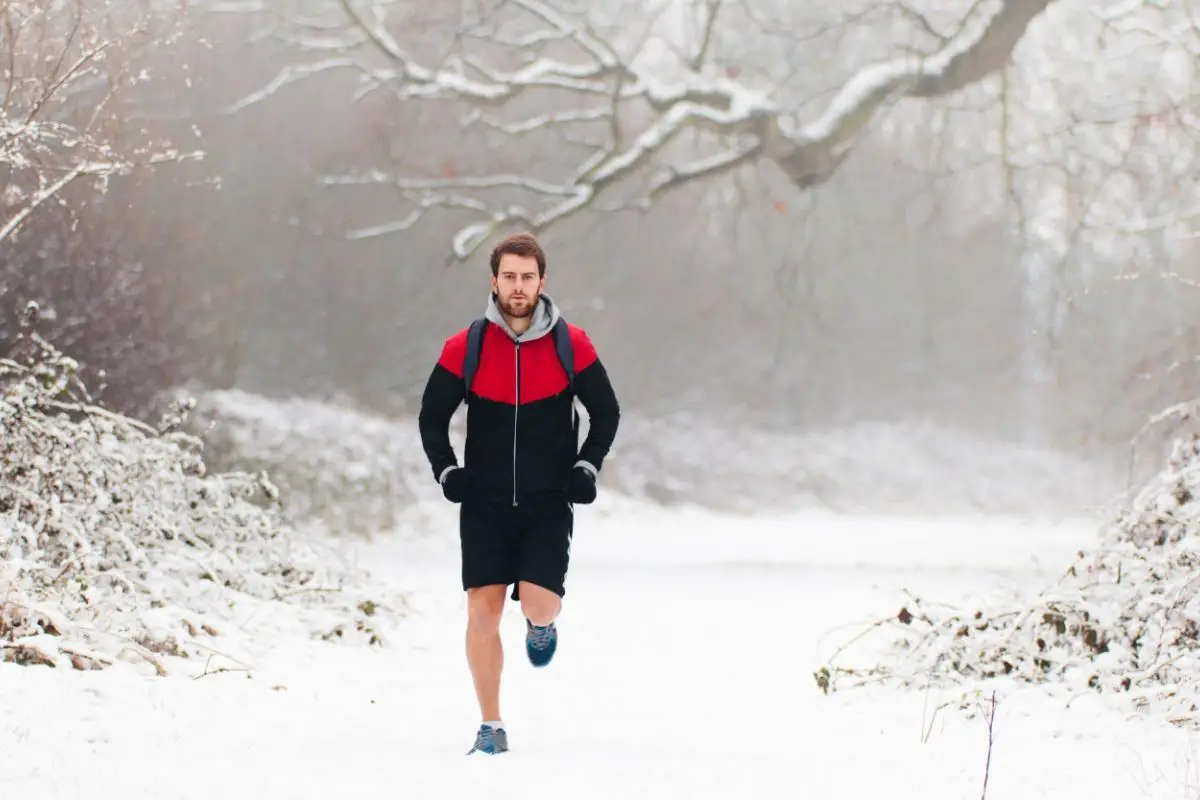How Cold Is Too Cold to Run? 3 Tips for Cold-Weather Running
Running in cold weather is a challenge even for experienced runners. But have you ever wondered how cold is too cold to run?
In this blog post, we’ll explore when is it too cold to run outside and discuss essential tips for adjusting your gear and training plan accordingly. Get ready to find out everything you need to know about running in the cold!
Cold temperatures below 32F (0 °C) should be considered too cold to run safely, increasing the risk of frostbite, as well as lung and heart disorders. However, you still can run if you consider appropriate clothing and safety rules to avoid negative outcomes while jogging in cold weather.
How Cold Is Too Cold to Run?
Can you run in negative-degree weather? To keep safe while running in the cold weather, it is important to be aware of when temperatures become too dangerous to run. According to the American College of Sports Medicine (ACSM), exercising outside when temperatures are colder than -8 degrees Fahrenheit (-22 °C) should be avoided.
Here is a table showing the comfortable temperature range for running during every season.
| Season | Temperature (°F) | Temperature (°C) |
|---|---|---|
| Winter | 30 to 50°F | -1°C to +10°C |
| Spring | 50 to 70°F | +10°C to +21°C |
| Summer | 65 to 85°F | +18°C to 29°C |
| Fall | 40 to 55°F | +4°C to 12°C |
Please note that these temperature ranges are general recommendations and may vary based on your region, preference, and individual health conditions.
At What Temperature Is It Dangerous to Run?
Generally speaking, anything below -8F (-22°C) should be considered cold enough to re-evaluate your running plans. You still can run at 20-30F (-1°C to -6°C) if you choose proper clothing and gear. At such temperatures, your body core needs more energy than it produces in order to avoid frostbite and hypothermia, so you need to protect it well enough.
It is always wise to take wind chill into account before heading out for a run. If the thermometer reads 36 degrees Fahrenheit but there’s a strong wind blowing that makes it feel significantly colder, runners should stay indoors until the winds die down.
3 Advantages of Running in Cold Weather
You might wonder is it bad to run in the cold or are there some advantages to doing so? Running in the cold may seem daunting at first, but it actually offers several unique benefits. Let’s take a closer look at them.
1. Mood Enhancement
When running in colder temperatures, the body releases endorphins that can improve mood and reduce stress. Research has shown that exposure to cold weather contributes to more vivid experiences of life, reducing symptoms associated with seasonal affective disorder (SAD). Running in the cold also activates neurons, which regulate levels of dopamine, furthering feelings of happiness and contentment.
The combination of daylight, cold air, and physical activity help keep the mind alert while preventing feelings of depression or anxiety connected to increased levels of darkness during winter months.
2. Increased Fat Burning
Running in cold weather can have positive effects on the body, including an increased capacity to burn fat. As temperatures drop, the body works harder to protect its core temperature, which means it burns more calories.
Cold weather exercise can make brown fat cells come alive, as the metabolism speeds up when exposed to cold conditions.
3. Stronger Immune System
Running in the cold can benefit your immune system by stimulating white blood cells, which help protect against infection. Your white blood cell count increases during winter months due to the lower temperatures.
These increased cell counts provide better protection from diseases and viruses and increase overall fitness levels due to a stronger immune system. Studies have shown that running at cooler temperatures has also led to improved alertness, higher mental clarity, and healthier rest patterns during nighttime hours.

5 Disadvantages of Running in Cold Weather
Despite these benefits, you still might be wondering is it dangerous to run in the cold? Cold-weather running does come with some drawbacks. Let’s discuss them in detail.
1. Lung Discomfort
When running in cold weather, runners may experience lung discomfort as a result of the dry air and low temperatures. Cold air irritates the lungs, making them narrow to try to bring in more warm, moist air to humidify the environment.
This can make it difficult for those with asthma or COPD to catch their breath during exercise, which can result in breathing difficulty, chest tightness, wheezing, or coughing.
2. Increased Risk of Injury
Running in frosty weather can increase the risk of regular running-related injuries, such as muscle and tendon strains or tears. The body’s response to colder temperatures is to restrict blood flow and reduce muscle movement, which may cause these types of injuries when running.
If you don’t take the time to warm up, your muscles and tendons are more vulnerable to injury, especially in colder weather.
3. Increased Risk of Heart Attacks
Cold weather can be dangerous for some runners because it puts more strain on the heart. Cold air constricts blood vessels, reducing the oxygen supply to the heart and making it work harder.
The narrowed blood vessels also reduce blood flow throughout your body, increasing your risk of heart attack. Cold temperatures can lead to increased resting and exercise-induced increases in pulse rate, as well as systolic and diastolic blood pressures. These are the key factors for cardiovascular disease risk. This means that you may experience chest pains more often during winter if you have a pre-existing heart condition.
4. Frostbite and Frostnip
Frostbite and frostnip are two skin injuries caused by cold temperatures. While both conditions can be dangerous, they differ significantly in terms of severity and degree of tissue injury.
Frostbite happens when a person’s skin is exposed to extremely cold temperatures for an extended period of time, causing cells to freeze or crystallize from lack of circulation. Symptoms include initial cold skin followed by a prickling feeling, numbness, hardening of the affected area, and pain after rewarming. It can go all the way down to the muscle and cause serious damage if left untreated.
Frostnip is less severe but still uncomfortable. Its symptoms include red or white patches on the exposed areas that feel cool or numb in touch due to decreased blood flow.
Subscribe to Our Running Newsletter!
Get free running tips from renowned professional athletes and discounts from top-notch brands.
5. Hypothermia
Hypothermia is a serious health risk for runners when exposed to cold temperatures for extended periods. It occurs when the body loses heat faster than it can produce it and results in an abnormal drop in core temperature.
Even though many people think hypothermia only happens during the winter, this condition can affect runners in the summer, too. It is essential for runners to understand the dangers of running while experiencing cold-weather conditions, as hypothermia can have short-term and long-term effects on their bodies if not treated promptly.
Running in Cold Weather: 3 Safe Tips for Training and Running
It is important to take extra precautions when running in cold weather, such as dressing in layers, protecting extremities with gloves or mittens, and ensuring running surfaces are not icy.
1. Dress in Layers
When running in cold weather, it is essential to dress in multiple layers. Layering clothing offers superior insulation, as well as flexibility and the ability to adjust depending on body temperature.
Pro Tip:
Close-fitting materials such as polypropylene or merino wool are good choices for base or mid-layer clothing. They help trap warm air while exercising and still allow regular cooling during your workouts.
It’s also very important to wear non-restricting clothing with moisture-wicking properties so sweat doesn’t remain trapped against the skin, which could cause chills and increased risk of injury while running.
2. Watch for Icy Surfaces
Slippery trails or roads can easily cause falls, which may result in broken bones, sprains, head injuries, and other potential injuries when running outdoors in cold weather.
Proper footwear should always be worn. Choose snowshoes/crampons equipped with spikes/teeth that provide a better grip on icy surfaces while remaining comfortable at the same time.
3. Stay Hydrated
Drinking plenty of water helps keep airways and the mouth moist, preventing breathing problems that can arise due to dryness caused by cold temperatures. In addition, staying well-hydrated during winter months can actually help keep you warm and healthy, as it reduces the risk of hypothermia and other health complications.
Consuming enough fluids while training or competing in such conditions also helps ensure your body does not lose all the moisture like it usually would, so your performance level remains high, even during long workouts.

How to Dress for Running in Cold Temperatures
When running in cold temperatures, it is important to dress with several layers of breathable fabrics and protective garments that cover the face, neck, and hands.
1. Layering with Sweat-Proof Materials
Whether you are running in temperatures ranging from 20 to 30 F or even colder, it is important to dress correctly. Layering with sweat-proof materials is especially recommended, as these can help regulate body temperature and keep you dry during your run.
Pro Tip:
Gear made from insulating materials such as fleeces and synthetic fibers traps air, helping to retain heat. Experienced athletes understand that metabolic heat production can lead to sweating, and that layering with a light jacket, fleece, or sweatshirt helps manage this moisture.
This type of layering also allows for easy adjustment when there are changes in environmental factors like wind speed or temperature, since multiple layers can be taken off if needed.
2. Accessories for Colder Temperatures
Various types of gear can provide additional warmth and protection from the elements.
Pro Tip:
Thermal base layers such as long underwear made from synthetic or wool materials are recommended for more extreme temperatures. Windproof outer layers can help protect you from wind chill, while a beanie hat will keep your head nice and warm on colder days.
Face masks, neck warmers, balaclavas, and gloves/mittens can be added if desired for extra insulation during cold spells. For maximum safety when running in very icy conditions, traction cleats or ice grips may also be necessary.
3 Alternatives to Running in Cold Weather
For those who are sensitive to the cold, there are a variety of alternatives for staying fit during the winter months, such as treadmill running, cross-training activities, HIIT training, and yoga or strength training.
1. Treadmill Running
Treadmill running can be a convenient and safe alternative to running in cold weather. For starters, training on a treadmill is generally safer than running outdoors, since there’s no risk of ice or other surface hazards that are often present in the winter months.
Additionally, treadmills are easier on your joints due to their cushioned belts, which absorb much of the impact shock associated with running on traditional outdoor pavement.
2. Cross-Training Activities
Cross-training offers runners the opportunity to maintain their cardiovascular fitness and prevent overuse injuries while still enjoying activities outdoors or in warm, indoor environments.
Options for cross-training include indoor workouts such as cycling, swimming, tennis, and high-intensity interval training (HIIT). A combination of these activities can help with balance and flexibility while also improving overall athletic performance.
3. Yoga or Strength Training
Yoga and strength training can provide important benefits for runners in cold weather. Incorporating these activities into an exercise routine will give the body better flexibility, increased strength and core stability, and improved mental focus.
Yoga helps with stretching, muscle recovery, and calming of the mind, which in turn assists with managing stress levels. Strength training is particularly useful for building endurance by targeting muscles repeatedly while avoiding overloading the joints.
Frequently Asked Questions About Running in Cold Weather
How Cold Is Too Cold to Run in Shorts?
Running in shorts can leave you at risk for developing hypothermia and frostbite due to lack of warmth against your skin, so it is best avoided when temperatures dip below 32 F. Additionally, always check the “real feel” or perceived temperature before hitting the track with short clothing.

Are 30 Degrees Too Cold to Run in?
While 30 degrees Fahrenheit may not seem too cold for running in, the added wind chill factor can make it dangerous. While it is technically possible to run outside in 30 degrees, it is important to prepare appropriately and to check the wind chill before heading out.
Is It Too Cold to Run in 20-Degree Weather?
Running in 20 degrees is usually considered comfortable for most runners if dressed properly. In fact, some would argue it’s the perfect temperature to get out and be active without feeling too cold.
Final Thoughts on Running in Cold Weather
The decision to run in cold weather comes down to personal preferences and your cold tolerance. Understanding the risks of running in such temperatures is important, but so is recognizing the potential benefits.
During extreme winter conditions, it is best to mix outside runs with indoor workouts or other low-impact activities like yoga and strength training. With a good understanding of what temperature is unsafe to run in and some safety tips for training in the cold, you’ll be armed with everything you need to make an informed decision when considering whether or not it’s too cold to go out for a run.
Have you ever tried running in the cold weather? Please share your experience in the comments below.
Also read:
- Numb Toes When Running
- Running in 100 Degree Weather
- Groin Pain in Runners
- What to Wear Running in 40 Degree Weather
- Ball of Foot Pain When Running
- Running on Grass vs Concrete
- Running 7 Miles a Day
- Running vs Sprinting
- Best Trail Shoes for Forefoot Runners
- Best Running Shoes For Achilles
References:
- Human mood and cognitive function after different extreme cold exposure // ScienceDirect: https://www.sciencedirect.com/science/article/abs/pii/S0169814122000774
- How can our health benefit from colder temperatures? // Medical News Today: https://www.medicalnewstoday.com/articles/320214
- Is Cold Weather Bad for Your Lungs? // AARP: https://www.aarp.org/health/conditions-treatments/info-2023/is-cold-weather-bad-for-your-lungs.html
- Tips for Outdoor Exercise in Cold Temperatures // American Lung Association: https://www.lung.org/blog/outdoor-exercise-winter
- Will cold weather affect my heart condition? // British Heart Foundation: https://www.bhf.org.uk/informationsupport/support/practical-support/will-cold-weather-affect-my-heart-condition
- Frostbite and Other Cold-Weather Foot Conditions // Verywell Health: https://www.verywellhealth.com/frostbite-and-other-cold-weather-foot-conditions-1337761
- Prevent Hypothermia & Frostbite // CDC: https://www.cdc.gov/disasters/winter/staysafe/hypothermia.html
- Practicing Sport in Cold Environments: Practical Recommendations to Improve Sport Performance and Reduce Negative Health Outcomes // PMC: https://www.ncbi.nlm.nih.gov/pmc/articles/PMC8471173/
- Hydration in Cold Weather // Penn State Extension: https://extension.psu.edu/hydration-in-cold-weather
- Everything You Need to Know About Running in Cold Weather // Cleveland Clinic Health Essentials: https://health.clevelandclinic.org/everything-you-need-to-know-about-running-in-cold-weather/
If you have any questions or suggestions, you can contact us via email – [email protected]






